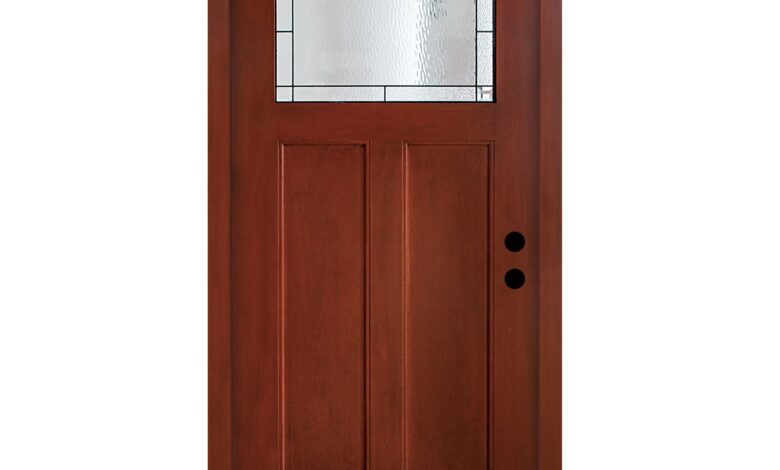Craftsman Front Door: Durability Meets Aesthetic

A craftsman front door has become a hallmark of American home design, blending timeless architectural beauty with practical durability. Originating from the Arts and Crafts movement of the early 20th century, these doors emphasize honest craftsmanship, natural materials, and functional design. Today’s homeowners choose a craftsman front door not just for its distinctive visual appeal, but also for its ability to withstand decades of use while maintaining structural integrity. The characteristic features—clean horizontal lines, sturdy construction, and thoughtful details—create an inviting entrance that enhances curb appeal and home value. Whether you’re restoring a historic bungalow or adding character to a modern home, understanding what makes a craftsman front door both beautiful and long-lasting helps you make an informed investment. These doors represent more than just an entry point; they’re a statement about quality, authenticity, and enduring style that continues to resonate with homeowners seeking both form and function in their exterior design choices.
Understanding Craftsman Style Front Doors
The craftsman front door emerged from the Arts and Crafts movement, which rejected mass production in favor of handcrafted quality and honest materials. These doors distinguish themselves through design elements that have remained remarkably consistent for over a century. The most recognizable feature is the emphasis on horizontal lines and geometric patterns, often incorporating divided glass panels in the upper portion that allow natural light while maintaining privacy. Unlike ornate Victorian styles, the craftsman front door celebrates simplicity and proportion, with clean lines that draw the eye without overwhelming the senses.
Construction typically features solid wood or wood composite materials with visible joinery that showcases skilled craftsmanship rather than hiding it. Many craftsman front doors include a substantial top rail with glass panels divided by wooden muntins, creating a balanced composition that feels both substantial and welcoming. The lower portion remains solid, providing security and insulation, while the upper glass section brightens entryways. Hardware choices complement the straightforward aesthetic—think simple, functional handles and hinges in oil-rubbed bronze or matte black finishes rather than polished brass flourishes. Traditional color palettes favor earth tones and natural wood stains, though modern interpretations of the craftsman front door successfully incorporate bold colors while maintaining the style’s integrity. The door’s thickness and weight communicate quality immediately, with most authentic craftsman front doors measuring at least one and three-quarter inches thick, creating a sense of permanence that lighter, hollow-core alternatives cannot match.
Design and Aesthetics
The visual appeal of a craftsman front door lies in its balanced proportions and thoughtful details that create lasting impressions. Glass panels typically occupy the upper third of the door, divided into rectangular or square sections by sturdy muntins that form geometric patterns—commonly three, four, or six lights arranged horizontally. This configuration serves dual purposes: flooding interior spaces with natural light while the substantial lower panel maintains structural strength and privacy. The wood grain itself becomes a design element, with quarter-sawn oak, mahogany, and Douglas fir displaying distinctive patterns that enhance rather than compete with the door’s lines. Decorative elements remain purposeful—beveled glass adds visual interest while maintaining the clean aesthetic, and raised panels provide depth without excessive embellishment.
The craftsman front door also complements a variety of home exteriors. The surrounding trim and sidelights follow the same principles, with simple, wide casings that frame the entrance without distraction. This restraint creates a cohesive appearance that ages gracefully, avoiding trendy details that quickly date a home’s exterior.
See also: What to Fix First When Updating a Home
Material Quality and Durability
The longevity of a craftsman front door stems directly from superior material selection and construction methods that prioritize substance over shortcuts. Solid hardwoods remain the gold standard, with old-growth Douglas fir, white oak, and mahogany offering exceptional dimensional stability and resistance to warping. These dense woods naturally resist moisture penetration and insect damage while providing the structural integrity needed for doors that may weigh 200 pounds or more. The grain structure of quarter-sawn lumber, traditionally preferred in Craftsman construction, minimizes expansion and contraction across seasonal humidity changes.
Modern engineered wood cores wrapped in hardwood veneers offer comparable performance at reduced weight, while fiberglass alternatives replicate authentic wood textures without concerns about rot or warping. Quality manufacturers of craftsman front doors employ mortise-and-tenon joinery rather than simple butt joints, ensuring tight, long-lasting connections. Exterior-grade adhesives and corrosion-resistant fasteners strengthen critical stress points. Multiple coats of marine-grade varnish or catalyzed finishes create durable moisture barriers that penetrate deep into the wood fibers. Glass selections matter too—tempered or laminated safety glass ensures safety, while insulated double-pane glass reduces heat transfer. Weather-stripping systems with magnetic seals maintain effective insulation and block dust and insects through thousands of open-close cycles.
Corrosion Resistance
The hardware of a craftsman front door must withstand constant exposure to outdoor conditions. Stainless steel hinges—especially marine-grade 316 alloy—resist rust even in coastal climates. Solid brass hardware develops a protective patina rather than corroding, while powder-coated finishes maintain consistent appearance over time. Thresholds and sills require equal care, as horizontal surfaces often collect standing water. Aluminum thresholds with thermal breaks prevent galvanic corrosion where metals meet, and sloped designs shed water efficiently. Stainless steel screws prevent rust stains from appearing through finish coats, and high-quality sealants maintain flexibility despite UV exposure. Together, these features ensure the craftsman front door retains its function and elegance across decades.
Temperature Changes
A craftsman front door must endure seasonal temperature shifts without warping or cracking. Dense hardwoods like mahogany and vertical-grain fir expand and contract minimally, making them ideal choices for this style. Proper installation allows for slight seasonal movement, typically with an eighth-inch gap concealed by weather-stripping. Darker finishes absorb more heat, so lighter tones may be preferable in hot climates to prevent surface degradation. Insulated cores help regulate interior temperatures, while architectural overhangs and storm doors add extra protection from direct sunlight. Regular maintenance—checking finishes, seals, and hinge alignment—ensures continued stability through years of temperature fluctuations.
Installation and Maintenance
Installing a craftsman front door correctly ensures its longevity. The frame must be perfectly plumb and level, with shims positioned behind hinges for solid support. Expanding foam insulation seals gaps without distorting the frame, and the threshold should be sloped slightly outward to prevent water pooling. Once installed, maintaining a craftsman front door is straightforward but essential. Annual inspections help catch small issues early—look for cracks in finish coats, moisture damage, or loose weather-stripping. Clean glass panels with non-ammonia cleaners, and lubricate hinges annually. Refinishing every five to seven years, depending on sun exposure, keeps the door protected and visually appealing. Applying multiple thin coats of varnish or sealant ensures even coverage and long-term resistance to moisture and UV damage. Adding a storm door can further extend maintenance intervals by reducing direct exposure.
Conclusion
A craftsman front door represents a rare blend of aesthetic excellence and functional resilience that few architectural elements achieve so effortlessly. Its enduring popularity comes from design principles that value honest materials, skilled joinery, and balanced proportions. Investing in a craftsman front door—built with solid hardwoods, corrosion-resistant hardware, and weatherproof finishes—pays long-term dividends in performance, security, and visual appeal. Proper installation and regular upkeep preserve these qualities for decades. Whether you prefer a traditional wood version or a modern fiberglass alternative, the craftsman front door continues to symbolize the perfect union of craftsmanship and durability. For homeowners seeking an entrance that embodies warmth, quality, and timeless design, this door style stands as a lasting investment in both beauty and structure.




